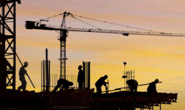Steel Markets

AGC Survey Measures Impact of Virus on Construction
Written by Sandy Williams
October 29, 2020
The COVID-19 pandemic is causing widespread damage to the nonresidential construction industry, says a new survey from the Associated General Contractors of America. More firms are reporting project delays or cancellations and construction employment levels are falling across U.S. metro areas.
“The survey results make it clear that the months-long pandemic is undermining demand for projects, disrupting vital supply chains and clouding the industry’s outlook,” said Ken Simonson, the association’s chief economist. “Without new federal relief measures, these challenges pose a significant threat to current construction employment levels.”
Simonson said three-quarters of construction owners in the September survey said they have had a project postponed or canceled, up from 60 percent in August and 32 percent in June. Eight percent report a cancellation or postponement of a project scheduled out as far as July 2021 or later.
Seventy-eight percent of respondents said they have projects under way that have been delayed or disrupted. Of that total, 42 percent cited shortages of construction, materials or parts and 34 percent cited the difficulty of finding craftworkers and/or subcontractors.
The strongest areas of nonresidential construction continue to be the building of distribution centers and data centers. As online shopping increases during the pandemic, so does the need for last mile warehousing and internet support. Firms report projects for commercial remodeling to facilitate social distancing, screening and testing facilities, said AGC. Medical facility expansions are expected to decline due to reduced revenue as patients delay routine appointments and elective procedures.
As current projects are completed, the prospects for new projects become scarcer, said Simonson. Optimism is down in the face of uncertain demand conditions. Thirty-four percent of firms in the survey do not expect business volume to return to pre-pandemic levels for at least a year. A majority of firms plan to cut staffing or freeze hiring during the coming year. Twenty percent of respondents said they will reduce headcounts and 42 percent said they will maintain current employment levels.
The migration of urban dwellers to the suburbs supports mostly residential construction but has ancillary benefits to nonresidential in areas of road construction, underground utilities, etc. Shortages of lumber have impacted home building, but AGC sees the segment continuing to be robust.
Employment levels for nonresidential construction declined 0.02 percent, according to September data, and are expected to remain flat or decline in October. Residential construction employment is increasing faster than the overall economy and was up 2.9 percent at the end of the third quarter, said Simonson.
AGC said federal relief measures are needed in all sectors of the construction industry, including new federal investments in infrastructure, liability reforms that protect responsible firms from frivolous coronavirus suits, a new highway and transportation bill and another round of Paycheck Protection Program loans.
When asked which might better serve the construction industry, a Trump or Biden administration, Simonson started by noting the current administration’s failure to deliver on an infrastructure package.
“Four years ago, we heard about a record infrastructure package and heard about it right through 2019, but the Trump administration never came forth with a detailed package, never worked to persuade Senate Republicans to pass something,” said Simonson. “Former Vice President Joe Biden has made it clear he supports a broad range of infrastructure work including funding for transportation, electrical storage facilities and renewable energy. Enactment of a bill, however, will depend on the composition of the Senate. Legislators can move fast when aligned with the president, otherwise it can take a long time.”
“As our survey shows, the pandemic and efforts to mitigate its spread have deeply wounded the economy, depressing demand for many types of commercial construction projects,” said Stephen E. Sandherr, AGC’s chief executive officer. “Congress can end the downward economic slide and help create needed new construction jobs by passing measures to boost demand and protect honest employers.”
View the AGC survey results. View the metro employment 12-month data, rankings, top 10, and map.

Sandy Williams
Read more from Sandy WilliamsLatest in Steel Markets

CRU: Sheet import demand softens as domestic price gains have slowed
US domestic sheet price gains have begun to slow as previously pulled-forward demand has led to a decline in orders.

CMC looks beyond Arizona micro-mill woes to long-term viability of construction mart
Despite the economic and geopolitical upheaval of the last five years, CMC President and CEO Peter Matt points out that the construction market has been an essential element of the way forward.

US importers face stricter rules under revamped S232 tariffs
“CBP expects full compliance from the trade community for accurate reporting and payment of the additional duties. CBP will take enforcement action on non-compliance," the agency said in a March 7 bulletin.

Steel exports rebound in January
US steel exports recovered to a five-month high in January after having fallen to a two-year low in December. This growth follows four consecutive months of declining exports.

Construction spending drops marginally in January
Construction spending edged down slightly in January, slipping for the first time in four months. The US Census Bureau estimated spending at a seasonally adjusted annual rate of $2,196 billion in January, down 0.2% from December’s downward revised rate. The January figure is 3.3% higher than a year ago. January’s result, despite the slight erosion, […]
